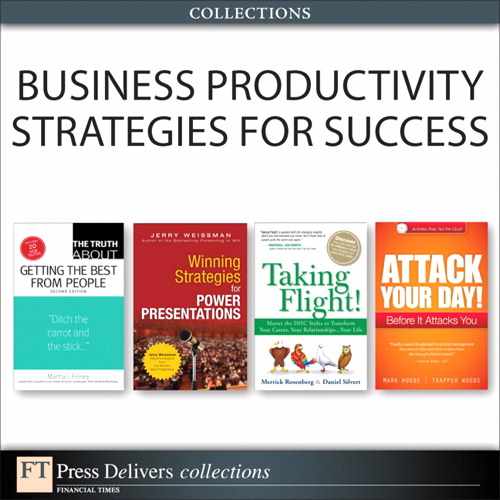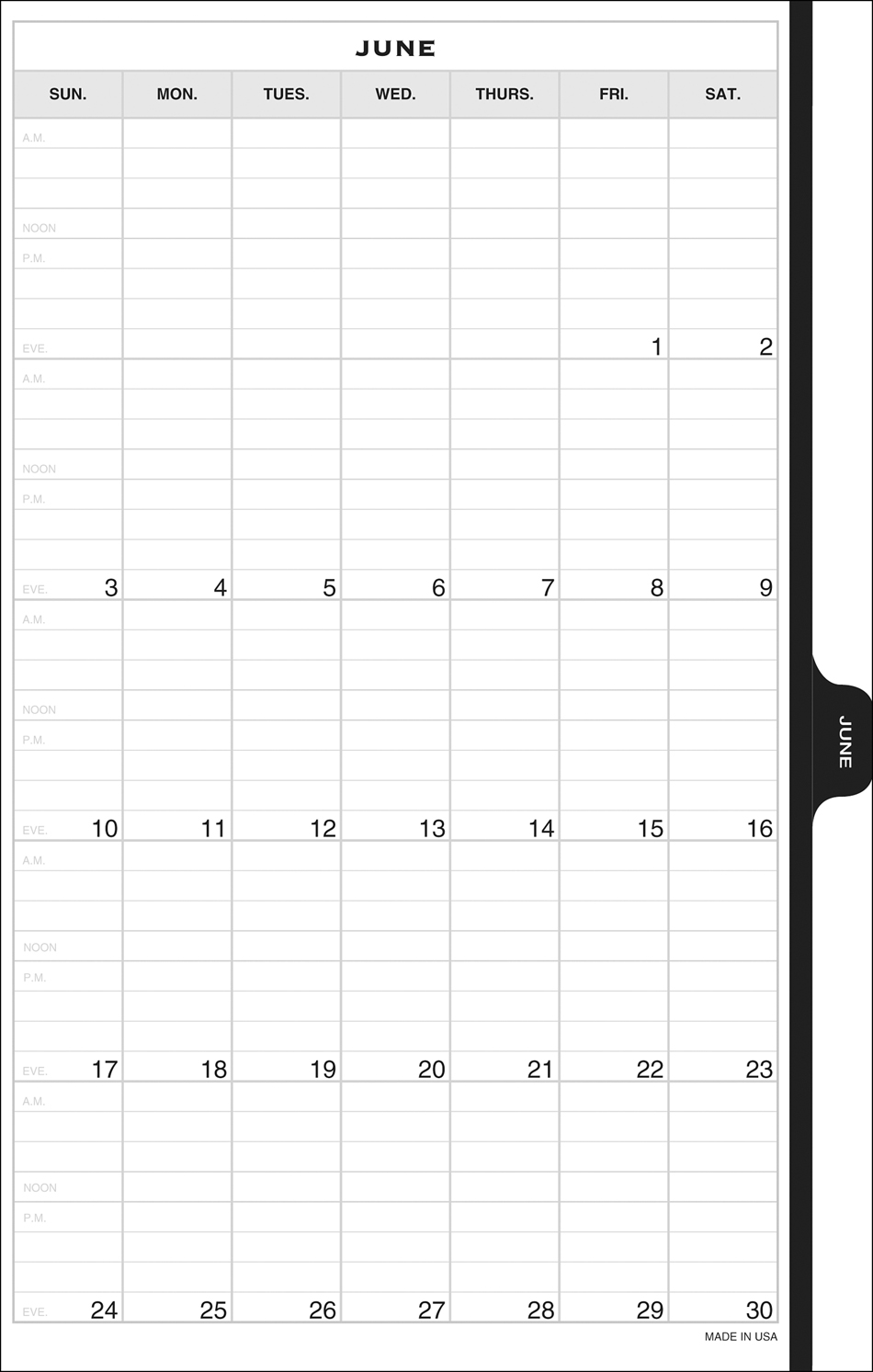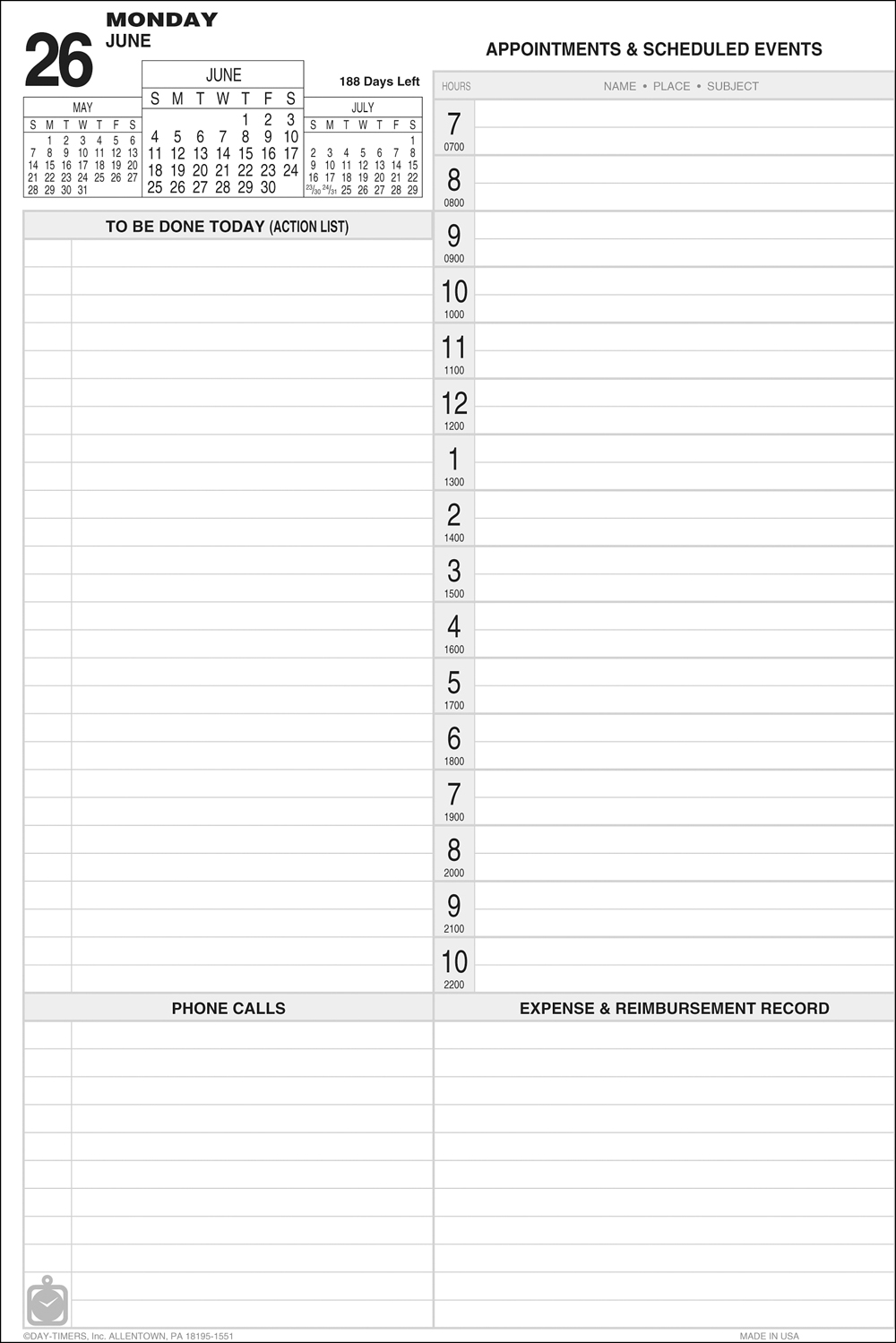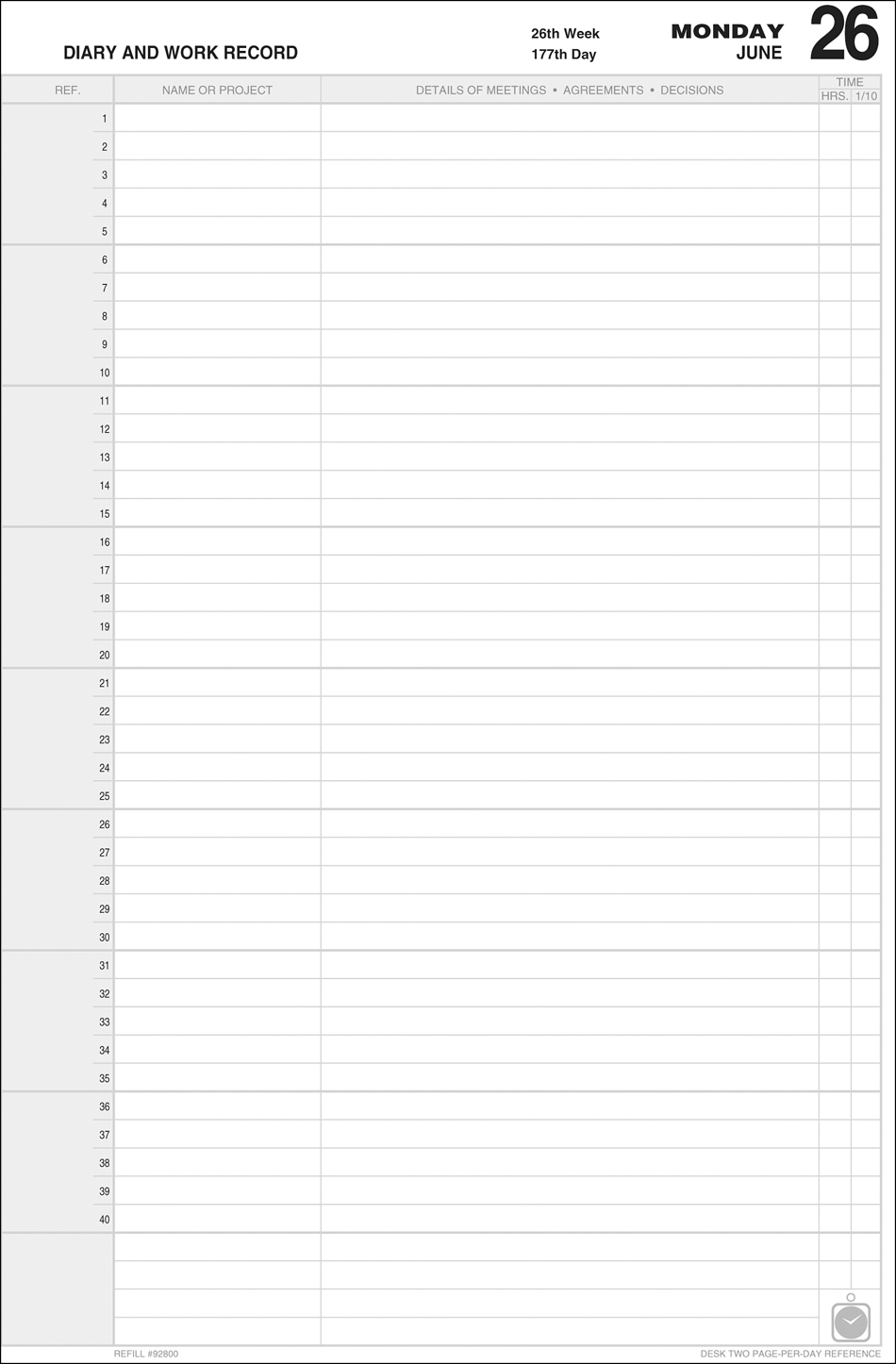Chapter 3. Carry Your Time in Buckets
Fine-Tune Your Tools
The next crucial self-management skill is activity tracking. This involves keeping track of intangible things such as thoughts, ideas, talking points, dates, promises, reminders, and strategies.
These intangible things must be organized and tracked so nothing falls through the cracks. This is especially crucial in this era of information overload. This is where the right time/activity management tools come in.
Time management tools today are innovative, clever, and even astounding. In some cases, they are also very expensive. The selection from which to choose is huge and includes both electronic devices and paper planners. So the questions are, “What kinds of tools are best for you and your lifestyle?” “Should you use a paper planner, an electronic planner, or a combination of paper and electronic devices?”
I was flying on a commuter jet one morning. Sitting across the aisle from me was an obviously effective executive. She had a palm computer in one hand and a cell phone in the other. I thought to myself: If ever there was an executive who was totally paperless, it just might be this woman.
When we leveled off at 10,000 feet, I thought, “Now I bet she’ll take out a laptop,” but not so. She took out a paper Day-Timer® Organizer. I introduced myself and asked, “How come? Why do you use a paper planner when you are so good with electronic tools?” She said, “Well, there are many things in my business that don’t track well electronically. That’s why I augment my electronic systems with paper.”
Keep It Simple
Many people operate this way. They use a combination of paper and electronic. Others operate strictly with a paper planner, and some are electronic only. The key is to keep it simple. If you combine tools, you should be sure they don’t duplicate functions. For example, don’t try to operate on two calendars.
Let’s face it: Time management tools do not manage time. People manage time. The tools are designed for one thing. They help us track the events and activities crucial to us.
Here is an easy way to think of and use time/activity management tools. Think of them as buckets. A bucket is used to collect and carry things. Paper planners, palm computers, and smartphones contain buckets in which we collect and carry data and plans for activities and events.
To ensure nothing falls through the cracks, we suggest you always carry six buckets, which are essential for effective time/activity management.
Bucket One—The Monthly Calendar
Bucket one is the monthly bucket or, in other words, your monthly calendar. Monthly calendars can be paper or electronic. (See Figure 3.1 for an example of a typical paper monthly calendar.) It is for collecting and carrying future events and scheduled activities. You’ve likely been using a monthly calendar this way for years.
Figure 3.1. The monthly calendar (© Day-Timer, Inc.)
If you’ve known an event or activity was going to occur on some future date, you simply wrote it on your calendar on that future date. Nothing hard about that!
However, many people do not use their calendar as effectively as they could. It is critical they do, though, because bucket number one, the monthly calendar, is like a master control panel. It’s the one place we can go and quickly see all of our scheduled future commitments, both personal and business.
To maximize the power of bucket one, and to ensure it really is your master control panel, use the monthly calendar for ADD. We aren’t talking about Attention Deficit Disorder here. We are talking about all
• Appointments, and all
• Dates, and all
• Deadlines
The Most Important Appointment
Let’s consider appointment activities for a moment. When scheduling appointments, remember the most important appointments you ever schedule on your calendar will be the appointments you schedule with yourself.
Take a look at your calendar for the past few months. Have you made any appointments with yourself and honored them the same way you treat your appointments with others? If not, you are not taking advantage of one of the most beneficial calendaring techniques.
What is the objective of self-appointments? They are for solitary focus time when you can accomplish your green activities. People who expect this kind of time to materialize without scheduling it usually come up short.
In the new time integration paradigm, we suggest that both business and personal appointments go on the same calendar. Some people attempt to use two different calendars, which increases the likelihood of losing control.
Dates and deadlines are also crucial in making your monthly calendar a master control panel. Many people fail to put deadlines on their calendar. Some people don’t keep their calendars current, and they become unreliable. If you want activity management to be ridiculously easy, keep your calendar current.
Select a paper or electronic calendar that you will be willing to carry with you. Like a wristwatch, accessibility of your calendar is essential in today’s mobile and virtual work environment. Take it to meetings. Have it with you when you go to confer in another person’s office. Invariably, you’ll be contacted all day long by others asking for some of your time. If you have bucket one accessible, you won’t have to get back to people.
Please take a moment now and evaluate your effectiveness in using a monthly calendar. If you use a combination then check both paper and electronic. My monthly calendar for future events and activities that are scheduled is
_____ Paper
_____ Electronic
_____ Don’t use one
My effectiveness rating is

Bucket Two—The Catch-All Bucket
Bucket two is the catch-all bucket. (See Figure 3.2 for an example.) It is similar to the monthly calendar bucket in that it’s a place to hold future events and activities. The difference is that the future events and activities in the catch-all bucket have yet to be scheduled. In other words, you know you are going to do these things in the future, but you aren’t exactly sure when. Certainly you won’t do them today, probably not tomorrow, and maybe not even next week. The catch-all bucket gives you a good place to track these things so they won’t be forgotten. Catch-all buckets can be paper or electronic.
Figure 3.2. Bucket two—The catch-all bucket (© Day-Timer, Inc.)
For some paper planners, the catch-all bucket is on the back of the monthly calendars, titled “To Be Done.” You can also set up an electronic catch-all bucket, or you can designate some sort of journal for that purpose.
It’s easy to spot people who don’t have a catch-all bucket. Their pockets, handbags, and desktops are usually cluttered with little pieces of paper on which they carry vital information. They can often be seen frantically searching for that one piece of paper with the information they need at that moment.
We believe bucket number two is almost as essential as bucket number one. This bucket exists for RAM. We aren’t talking about your computer’s RAM here; we are talking about Reminders, Avoiding FPAA, and Master Task List.
• Reminders. People have so much to remember it is difficult to track it all in our minds. Anytime you want to remember anything, just put it in your catch-all bucket.
• Avoiding FPAA. That’s an acronym for Floating Paper Anxiety Attack! We think you know what we’re talking about. We get caught in a situation without something to write on, so we grab any old piece of paper to capture an important message. Then, for some reason, that paper gets lost or floats away, and up goes our anxiety because it contained very important information.
I’ve watched people make important notes on napkins, business cards, pieces of yellow legal paper, wallpaper, yellow stickies, and even the palm of their hand.
We were conducting a time management seminar in Oklahoma City one day. When we started talking about floating paper, the manager of the group stood up and said, “Hey! Do you mean like this?” and he pulled two big wads of paper out of his trouser pockets. I said, “Yes, like that! That’s a complicated way to track events and activities.”
If you want ridiculously easy time management, have one catch-all bucket where you put all the information that’s handed to you on floating pieces of paper. It takes just seconds to transcribe the information. Then, throw the little bits and pieces of paper away. Life will be amazingly simpler, and you’ll have less anxiety.
• Master Task List. Everybody has a list of stuff they need to remember to do each month. The catch-all bucket is a place to build a summary of such things.
For example: Before the end of the month, you want to purge your files. Put that in your catch-all bucket. You won’t forget it, and you’ll increase the likelihood it will get done.
WARNING! A catch-all bucket is not much help at all unless it is checked each morning as part of the planning process. It takes very little time to scan the information. Please take a moment and evaluate your effectiveness using a catch-all bucket.
My catch-all bucket for future events and activities that are not yet scheduled is
_____ Electronic
_____ Don’t use one
My effectiveness rating is

Bucket Three—The Daily Bucket
Bucket three is a bucket for today’s activities. (See Figure 3.3 for a typical example.) We call it the AAA bucket. And, as you may well have guessed, we aren’t talking about the American Automobile Association.
Figure 3.3. Bucket three—the daily bucket (© Day-Timer, Inc.)
We are talking about
• Appointments: today’s appointments
• Action list: today’s activity list or to-do’s
• Additions: things that pop up during the day
What do we mean by additions? Additions are the “expected/unexpected” activities and events that pop up each day after we’ve made our plan. They are the red events in our daily traffic that require us to stop what we are doing, or what we planned to do, and go do this red event right now! We think there is worth to adding these to our original action list, and taking credit for getting those jobs done by checking them off.
Almost all paper and electronic planners have a space for today’s appointments and action list. Bucket three functions like a compass. It shows us what we plan to do next. It shows us where we are headed and what we’ve scheduled to be doing at certain times. It also provides a place for us to note the “expected/unexpected” things that pop up during the day—the additions.
On the following page is an example of a typical Day-Timer® Organizer. The advantage of paper is that you can see both your scheduled and unscheduled activities in one view. If you prefer electronic, there’s an app for that. We suggest you choose one that is simple, easy to navigate, and that you’ll enjoy using daily. Consistency is key.
Most people are pretty good at having a place to track their appointments for the day. We are concerned, however, when we see people who don’t take the time to make a simple action list for the day. Interestingly, some time management experts tell their clients it doesn’t make sense to plan an action list at the beginning of the day because things change so fast. Their argument is that the plan might be obsolete as early as 8:00 or 9:00 in the morning, so that kind of planning is a waste of time. We disagree with that idea.
When we build a list of planned activities for the day, an action list, and we put a value on those activities, four incredible benefits accrue to the ridiculously effective activity manager.
These benefits are still there even when things change and the list becomes obsolete when interruptions occur. Here are four HUGE benefits:
1. The list becomes a tool of negotiation. It can be used as a tool of negotiation with yourself when you are tempted to be swayed by lower priorities. It can also be used as a tool of negotiation with others when they want you to subordinate your priorities to theirs.
2. It becomes a tool of navigation to help you get back on track after you’ve dealt with emergencies—red events you had to resolve.
3. It becomes a tool of focus because it functions like a magnifying glass to help you concentrate your physical, mental, and emotional energy on the right activities throughout the day.
4. It becomes a tool of measurement to help you evaluate your progress during the day, and shows the status of each planned activity at the end of the day.
Why would anybody want to run headlong into the whitewater of the day without an action list when it produces such benefits?
Please take a moment and evaluate your effectiveness using your daily bucket.
My daily bucket used for today’s events and activities is
_____ Paper
_____ Electronic
_____ Don’t use one consistently
My effectiveness rating is

Bucket Four—The Memory Bucket
Bucket four is the memory bucket. It’s the place for DDT. Clearly, we are not talking about pesticides here. We are talking about
• Documenting important information
• Delegating to and receiving delegation from others
• Tracking a sequence of events and information you receive
It’s where we record important information that comes to us during the day—information we think we might need at a later date. During the day, we receive information in a variety of ways. It comes to us through telephone calls, drop-in visitors, email, voicemail, text messages, meetings, and conversations with others. We certainly don’t write everything down, but recording key information is crucial.
What we are talking about here is a permanent journal that is dated, sequential, and ultimately archived in such a way that you can retrieve the information, if necessary, years from the date it was recorded.
Choose the best tool that fits your style. All tools, paper or electronic, have resources that you can use as “buckets.” (See Figure 3.4 for an example of a dated paper memory bucket.)
Figure 3.4. Bucket four—the memory bucket (© Day-Timer, Inc.)
If you prefer electronic, there are thousands of apps to choose from. One we like and use regularly is Evernote. Evernote makes it easy and convenient to remember things using your computer, smartphone, tablet, and the web. You can also keep a memory bucket in Outlook using the note feature. This is convenient if you use the Outlook calendar for bucket 1. Whatever tool you use, keep it simple and accessible.
People who don’t use bucket four, the memory bucket, often resort to writing on legal pads, spiral notebooks, and loose pieces of paper. This can be risky. Remember this old Chinese proverb: “The palest ink is better than the best memory.” However, what you write down can’t be used as memory at all unless you have a good retrieval system for finding the information.
Because retrieval is so important, we recommend to all paper planner users that the memory bucket be paper, with the day’s date printed on each page. Then you can file these pages sequentially. Be sure to implement a simple filing method by date, category, or project.
If you want to make it ridiculously easy, settle on a dated paper journal for your memory bucket and use it consistently. Lack of consistency with this tool will make your activity management harder, not easier.
Please take a moment and evaluate your effectiveness using a memory bucket that is sequential and dated.
My memory bucket used for recording key information is
_____ Paper
_____ Electronic
_____ Don’t use one

Bucket Five—The Fingertip Data Bucket
Tracking bucket five is the data bucket. This is where we carry vital information that we need at our fingertips from time to time, and might include goals, projects, documents, spreadsheets, images, your address and telephone directory, fact sheets, and so on.
The purpose of the data bucket is to centralize the information we need at our fingertips. To centralize means to get all of our key information into one source. When we do that, we promote ridiculously easy activity management.
One of the huge advantages of a PDA such as a Blackberry, iPhone, Palm, and Android™ is that you can download all of your data from your computer into a small data bucket that you carry in the palm of your hand. If you have multiple electronic devices, keep bucket five in “the cloud.” Cloud computing allows you to store vital information retrievable from any device. People are no longer tied to any specific location or one device as they roam about to get things done on laptops, tablets, or even smartphones. Sync and share notes, Word documents, presentations, spreadsheets, images, and even video with ease.
The best solution for an electronic data bucket is an online storage service like Dropbox, Google Drive, Box.com, Microsoft’s Skydrive, or SugarSync.
If you do not use a PDA or smartphone, but instead use a paper planner, a tabbed index section serves as your data bucket. Another paper method would include the use of file folders. Keep them organized and accessible.
You can learn more about data bucket tools and get recommendations at our website attackyourday.com.
Please evaluate your effectiveness using bucket five, the data bucket.
My data bucket used for keeping vital information at my fingertips is
_____ Paper
_____ Electronic
_____ I’m not that organized
My effectiveness rating is

Bucket Six—The Communication Bucket
There is one more bucket that all of us use. It’s our electronic communications bucket or, in other words, our voicemail/email. Voicemail is not a major problem for most people, and most people don’t abuse it.
Email, on the other hand, is a minefield of distractions, irrelevancies, and a great temptation for time-wasting. It is, however, the biggest part of our communication bucket, and an essential component of activity management.
Today, most people live in their inbox. They leave it open all day as it constantly checks for new messages. When a new message comes in, an alert pops up treating every message as a high priority demanding our attention. Not only is this distracting, it breaks our focus and productivity goes down, way down.
Take back your inbox! Treat email as another activity on your activity list and schedule it. Check your email 3–6 times daily and use a system to prioritize and process your email. We address email later in the book. In the meantime, please evaluate your effectiveness using bucket six, your communication bucket.
When evaluating my communication bucket used for oral and written communication:
_____ I control it.
_____ It controls me.
My effectiveness rating is

Based upon your style, pick paper or electronic tools you will really use. If you are a visual person, you may be most comfortable with paper. Don’t let your peers intimidate you into going with an electronic tool if you know you won’t use it. Here’s a clue—if you use your PDA or smartphone only as an address/phone directory, you are probably better off using paper. On the other hand, if you prefer electronic tools and all the bells and whistles they offer, they can be very useful. The key is in finding what works for you, and then making sure you always have your six-pack handy:
• Bucket One—Your Monthly Calendar
• Bucket Two—Your Catch-All Bucket
• Bucket Three—Your Daily Bucket
• Bucket Four—Your Memory Bucket
• Bucket Five—Your Fingertip Data Bucket
• Bucket Six—Your Communication Bucket
Carry your time in six buckets. Check each bucket every day so that nothing falls through the cracks. It’s easy when you pick and use your buckets. Ridiculously easy!




